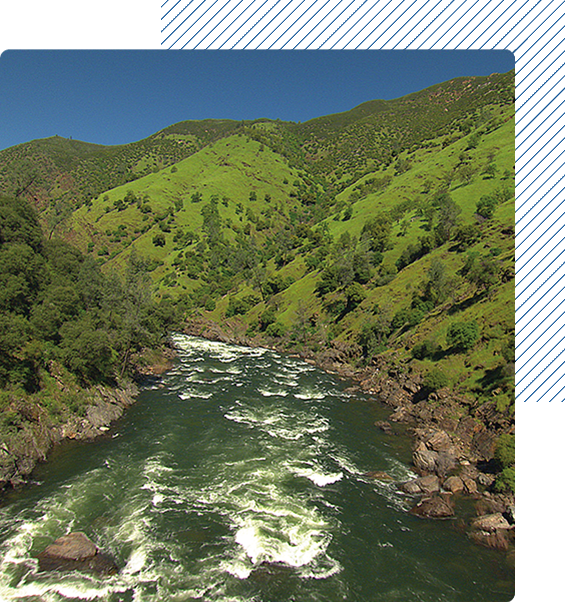
Tuolumne River
Specific Science
Solutions Built on Tuolumne Specific Science
Grounded in science, the Tuolumne River voluntary agreement is a revolutionary approach to managing and balancing water supplies to support thriving communities and fisheries.”
The Tuolumne River Partners have invested heavily in studying and truly understanding the Tuolumne River and the species and industries that depend on it. We’ve built an extensive record of research and river-specific science.
The Tuolumne River Partners have funded, conducted and completed more than 200 publicly available studies on the lower Tuolumne River. Some examples include spawning gravel study, predation study, swim tunnel study and floodplain hydraulic assessment. Some studies have been conducted for the relicensing of the Don Pedro Project, specifically.
Don Pedro Project Relicensing-specific Studies
Cultural Resources Studies: These studies examined archaeological sites and lands significant to Native American culture and California history.
Recreational Resources Studies: This research evaluated the condition of current recreational facilities, minimum river flow rates to sustain boating and options to improve whitewater rafting facilities.
Terrestrial Resources Studies: These studies focused on wetlands and habitats for birds, reptiles, bats and insects in and around the Tuolumne River.
Water & Aquatic Resources Studies: This research addresses fisheries and non-native predators, water flow, temperature and overall quality.
Selected Findings From the 200+ Studies on the Tuolumne
A joint study with California Fish and Wildlife of salmon otoliths (ear bones) indicate that if salmon are pushed out of the rearing habitat too early they do not return, likely due to predation.
Rainbow trout (O. mykiss) in the Tuolumne River can survive and thrive up to water temperatures of 23° Celsius, not the max of 18° some have claimed.
As much as 96% of salmon are consumed by non-native, predatory fish before they can ever leave the Tuolumne River.
Hatchery practices call for the fins to be clipped on 25% of the fish they release. Upon analysis, all of the salmon returning to the Tuolumne are hatchery strays and not native fish.
Hear more about
the Science from the experts
Andrea Fuller, FISHBIO Principal
Senior Biologist
Nann Fangue
PhD, UC Davis Chair, Dept. of Wildlife, Fish & Conservation Biology
Noah Hume
Stillwater Sciences Aquatic Ecologist/Senior Scientist
Scott BlankenshipCramer Fish Sciences/Genidaqs Senior Geneticist/Science Director
Mike Deas
PE, PhD Watercourse Engineering Principal

Study Examples
Swim Tunnel Study
We used cutting edge science to evaluate the aerobic capacity of O. mykiss (rainbow trout) at a series of increasing temperatures on the Tuolumne River.
The study showed that high thermal tolerance suggests that O. mykiss (rainbow trout) at the southern limit of their indigenous distribution may be locally adjusted relative to more northern populations than the Pacific Northwest temperature guidance that is currently being applied to the Tuolumne River. Tuolumne River science indicates fish are adapting to warmer river temperatures and don’t necessarily require more or cooler water to thrive.
Predation
As many as 90% of juvenile salmon leaving the Tuolumne River are eaten by non-native predators such as striped bass and black bass.
The Tuolume River Partners propose the construction of a barrier weir and other active predator collection and removal activities to help manage the predators in the prime spawning and rearing reaches of the lower Tuolumne River.
Agreements to Support Healthy Rivers & Landscapes
The Tuolumne River Partners have invested heavily in studying and truly understanding the Tuolumne River and the species and industries that depend on it. We’ve built an extensive record of research and river-specific science.
The Tuolumne River Agreements to Support Healthy Rivers & Landscapes provides a foundation for comprehensively managing the Tuolumne River. It provides benefits to fish and their habitats as well as to farms, businesses and communities that depend on the river for water supply.
Our license applications for the Don Pedro Project and La Grange Project as well as our Tuolumne River Agreements to Support Healthy Rivers & Landscapes reflect these investments in and our commitments to science.
Floodplain is limited. Via the Healthy Rivers & Landscapes Agreement, we’ll provide a new floodplain pulse flow to create at least 77 new acres of floodplain.
Predation is a significant limiting factor. Exercising the Healthy Rivers and Landscapes Agreement will suppress predators to dramatically improve outmigration success.
As part of the Healthy Rivers & Landscapes Agreement, we’ll provide timed outmigration pulse flows to coincide with juvenile readiness to out-migrate based on observed, real-time data.
Large woody debris is limited. Under the Healthy Rivers & Landscapes Agreement, we’ll add properly sized and located large woody debris to create favorable microhabitats and promote scouring of fines from spawning gravels.







